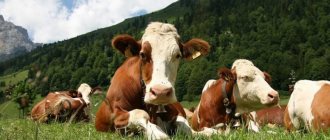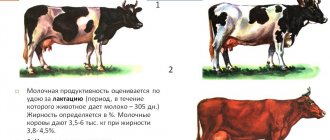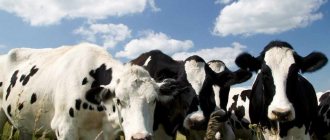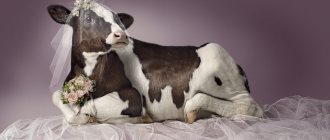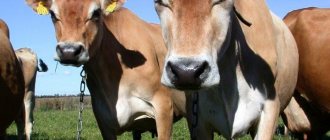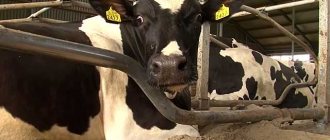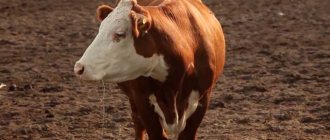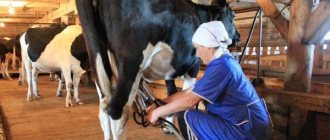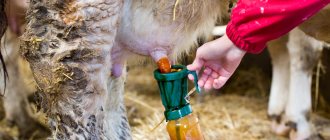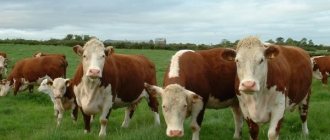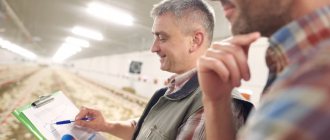What is the difference
For centuries, Russia and other countries around the world have cultivated the practice of keeping cattle in free herd conditions, which increased the physical capabilities of the animals at the expense of the rate of weight gain and milk production.
The free-stall method of keeping cows has always been considered low-cost, since several shepherds were required to herd cattle, and a fairly small number of milkmaids were required to obtain milk. This method of raising livestock does not require removing manure from pastures, where it became a natural fertilizer, and animals are driven into barns only during the autumn-winter season and bad weather. True, the average milk yield per cow is fixed at a fairly low level, which forced livestock breeders to use a more progressive method of keeping animals.
Modern tether housing for cattle is more labor-intensive, but it helps produce more milk and increase muscle mass in fattening animals.
Tethered housing in a stall
With this method of cattle breeding, animals are kept in a stall in a tied state (as a rule, a metal chain is used around the neck). For each cow, a barn area of up to 2.5 square meters is allocated. m with access to a feeding trough, on which she can freely stand, lie, feed and perform her natural needs without contact with other animals.
Today, more than 90% of the productive herds of both Russia and the industrialized countries of the world are kept in tethered conditions. The only exceptions are small farms, whose owners prefer to raise animals the old-fashioned way.
The main disadvantages of the tethered method is the need to attract an additional number of workers to clean the stall and feed the animals, as well as veterinarians who conduct periodic examinations and treatment of cattle.
It should be taken into account that the inactivity of animals kept in a stall inevitably affects their health, provoking the development of chronic diseases.
1.3.3. Arrangement of a barn for free-stall housing of cows.
The size of the box must be such that the animal can fit in it freely, and manure does not pollute the resting place. According to the requirements of technological design of cattle farms, the standard area for cows is 1.9–2.52 m2, box length 1.9–2.1 m, width 1–1.2 m (on average box length is at least 2 m , width - at least 1 m). Box dividers are made of one or two horizontal or bent elements (bars).
The outer boxes are separated from the verified passages by blind partitions, and the height of the section partitions is 1.5 m, the box fences are 1 m, and the combibox fences with fixation are 1.2 m.
Between the rows of boxes, usually in the middle of the building, there is a feeding platform or feeders. The width at the top of the feeder is 0.5 m, at the bottom 0.4 m. The height of the front side is 0.5 m, the rear side is at least 0.5 m. Length at the front 0.7-0.8 m. Mobile feeders are made in walking yards. Watering cows from automatic drinkers - one for 10-12 heads in box housing sections
The rows of boxes are divided into sections to accommodate different groups of cows. The sections have exits to walking areas, which are usually located on the south side of the building. Dividing animals into groups according to age, milk yield, and pregnancy period promotes differentiated group feeding, milking and maintenance.
Cowsheds with slatted floors and underground storage of manure.
The construction of such buildings is somewhat more expensive compared to the construction of conventional barns due to the construction of manure storage. However, it pays off in savings on bedding materials, labor costs for daily manure removal, as well as the cost of purchasing expensive manure removal mechanisms. The slatted floor in such barns is laid over the entire area of the feeding areas and in the aisles.
The multi-car conveyor consists of a wall of 60 stalls. Each was mounted on a two-axle cart moving on rails and equipped with a feeder, a water tank, a drinking bowl and a manure receptacle. The conveyors of the first two options do not provide for active exercise of animals.
A significant disadvantage of this technology is that the animals are forced to move at an angle to the direction of movement of the conveyor.
The essence of the flow-conveyor system is that feeding of animals is combined with their movement (exercise). With this type of feeding, a natural biological process of food consumption occurs, i.e., animals move freely and consume nutritionally balanced feed from individual feeders.
The basis of the new technology is the feeding hall, in which a feed dispenser with individual feeders moving along a horizontally closed suspended path is mounted. The speed of movement of the feeders is determined depending on the required productivity of the feed hall within the limits of speeds determined in pasture conditions.
The flow-conveyor system combines the advantages of tethered and free-stall housing methods and eliminates their disadvantages, ensures high labor productivity, helps increase the productivity of cows, brings the animal housing system closer to natural conditions and creates the possibility of complete automation of all production processes.
Read also: How to raise rabbits in the country
This technology, especially in areas where there is no pasture, should find application, although it is not without some drawbacks.
Advantages of tethered housing
Along with certain disadvantages, keeping cows and bulls on a leash also has significant advantages:
- cases of collisions between animals and their injury are excluded;
- each cow receives the required amount of feed, which cannot be taken away from it by a stronger animal;
- due to low mobility, the amount of feed consumed by cattle is reduced by 10-15%;
- it is convenient for dairy cows and fattening calves to be examined by livestock specialists and veterinarians, prescribing an individual or therapeutic diet;
- milk productivity of cows increases by 15-20%, and the daily increase in muscle mass of calves - up to 15%;
- The use of a milk line suspended above the stall simplifies the milking process.
With the correct layout of the stall, the urine and manure of animals should flow into special gutters through which they are transported outside the barns.
Removing cow dung is quite an expensive process, but fertilizing fields with it significantly increases the productivity of agricultural crops, and is very popular among small and medium-sized farmers.
Requirements for stalls.
To limit the movement of the animal, each stall is equipped with a locking mechanism. The main requirement for a harness is to ensure maximum safety for operating personnel, prevent injury to the animal, and ensure unhindered eating of food, standing and lying down. The optimal method of fixation is a tie method, when the chain is attached to the animal’s collar.
When designing stalls, it is necessary to take into account the average dimensions of the animals in the herd and optimize the manure removal system as much as possible. Typically, farms use long stalls (190-200 cm) with a concrete feeder and a partial absence of fences. With such an organization, 20-25% of the time spent on maintenance of the total working time is required. The practice of the best dairy farms that use tether housing shows that the optimal length, in the presence of front and side restraints (usually made of metal pipes), should be 5-10 cm shorter than the oblique length of the cow's body. This reduces the time spent on manure removal and results in less contamination of the animal. Tethered cowsheds are arranged with longitudinal placement of cows in two or four rows, which allows for maximum mechanization of feeding, watering, milking and manure removal. To remove manure, basement manure storage facilities, flushing systems, and stationary manure collectors (screw or scraper conveyors - TSN-2.0B, TSN 160, TS-IM) are used.
Keeping fattening calves and bulls
The tethered method of keeping animals fed for meat is considered the most effective today. To maintain a large fattening herd, it is enough to use small premises in which 2 to 2.5 square meters are allocated per animal. m area.
Tethered growing bulls do not have the opportunity to directly contact and achieve dominance over each other. Grown bulls are characterized by increased natural aggressiveness, and the chain harness eliminates the possibility of collisions between animals and their injury.
Using the tether method when fattening young calves allows you to control the level of appetite and health of each animal by adding the necessary veterinary products and bait to the feeder.
Calves kept in a stall in a tethered state move little and the feed is well digested, stimulating a rapid increase in muscle mass. If with the loose cattle keeping method it is almost impossible to raise a bull weighing up to 450 kg in 1 year, then with the tethered method this is a common occurrence.
Large American producers feed tethered animals with flakes made from corn grains with the addition of vitamins and steroids, achieving such weight gain even in 6-8 month old bulls.
Combined breeding
This is a more preferable method of keeping cattle, carrying out automatic fixation of animals in individual boxes and the milking procedure in the halls.
The technology combines high levels of staff efficiency, reduces problems with care and treatment, makes it easier to clean rooms, and requires a smaller area. With the box method, animals have less contact, preventing injury and reducing milk production. The great advantage of the combined technology is the ease of its implementation in standard barns. They are not very different from tethered housing - you just need to redo the stall system, replacing them with more modern ones.
An important point is the choice of stall length for combined housing. The box should be smaller than the cow by 5-10 cm in length, which will allow her to defecate into the manure collection trough. This makes maintenance easier. Also, the width of the boxes should not be more than a meter, so that the animal cannot turn around or fit diagonally. The height of the stalls is also important - if they rise less than 30 cm above the manure chute, the cow will lie down in the drains. If you do it higher, the injury to the limbs increases.
Keeping a dairy herd on a leash
As mentioned above, the world's leading producers are massively switching to this method of keeping cows, since it seriously reduces the cost of milk production, increasing their competitiveness in the market for such products.
Modern systems for automated milking and transportation of valuable products through milk pipelines, as well as machine cleaning of sewage channels, have made it possible to reduce the number of workers involved in production.
Centralized purchase of feed and removal of cattle waste also reduces costs; direct contracts with dairy industry enterprises make it possible to avoid the services of intermediaries.
The absence of stress and proper hygienic care allow, for example, Israeli producers to receive up to 1,700 liters of milk per month from each cow.
Stall-pasture method of keeping cattle
Depending on the natural conditions of the country and the availability of natural food supply, round-the-clock, stall-walking or stall-pasture keeping of cattle is used.
In Russia, due to the large amount of natural feed, the stall-pasture method of keeping a dairy herd is practiced, when in the spring and summer the animals are driven to natural meadows, and in the fall and winter they are kept in a stall.
This approach increases the quality and fat content of summer milk, and also strengthens the physical health of animals that move a lot and spend a long time in the fresh air. True, shepherds should carefully monitor the herd, separating from it cows that are sick or oppressed by other animals.
In winter, animals are transferred to tethered housing in barns. Veterinarians examine their physical condition, prescribing preventative antiparasitic or local treatment. Necessary medications or food supplements are placed in the feeder for each animal.
The essence of untethered content
Free-stall housing of cows is considered a more convenient method than tethered housing.
This allows the animal:
- move freely around the walking area;
- move a lot, which means less pain;
- communicate with other animals;
- choose a more comfortable place to relax;
- take a comfortable position while resting;
- produce more milk due to increased comfort.
The method is especially convenient for large livestock complexes and was originally practiced for keeping meat breeds. But now it is used in various types of farms for cattle, both meat and dairy.
Cows can be kept on deep bedding with resting areas or in individual boxes. Boxes can be combined with feeders or separated. In the second case, a special room is organized for feeding. Often the feeding area is combined with a walking area.
Feed distribution is carried out by a mobile feed dispenser. Milking takes place in a separate room on the “Yolochka” or “Tandem” installation. For proper operation of milking equipment, it is recommended to maintain a herd whose number of heads is a multiple of the milking units: 8, 16, 27, 32, etc.
Animals rest on deep litter. The microorganisms located in its layer create heat in the process of vital activity, so the barn does not need heating - it is provided by the animals themselves. The supply of bedding is 1 ton of material per 1 animal.
Did you know? Physiologically, cows are more comfortable lying down: at this moment, blood flows better to the udder, which increases milk production. Therefore, the place where the animal will rest must be comfortable.
The litter does not need to be changed very often, since manure is effectively removed by a tractor with scraper equipment.
Advantages
The benefits of a free-stall system primarily apply to animals.
In this regard, it is noted that:
- animals lead a more active lifestyle, which is good for health;
- immunity is strengthened;
- cattle productivity improves.
For service personnel, the system has both a number of advantages and some disadvantages.
Benefits for staff:
- labor costs for milkmaids and feed distributors are reduced;
- the milking process is simplified;
- all work related to the maintenance of cattle is accelerated;
- the manufacturability of the complex increases.
Flaws
Group housing of cows increases feed consumption by 10%.
Among the disadvantages for animals, the most often cited are:
- lack of an individual approach to feeding - the animal may overeat, which is not very good;
- the lack of specialists who are well-versed in the technique can cause deterioration of living conditions, increased humidity, untimely cleaning or renewal of litter, and as a result, an increase in morbidity;
- complicated care for individual animals in the event of an epidemic situation.
Important! Aggressive cows should not be kept in loose housing. This increases stress and reduces livestock productivity.
For milkmaids and feed distributors, the system has no disadvantages, but for livestock specialists there are:
- veterinary procedures become more difficult;
- Difficulties arise in caring for a sick animal.
The reasons for transferring to loose housing are the following:
- increasing automation and mechanization of cattle keeping in order to increase productivity;
- optimization of production and reduction of animal maintenance costs;
- the need to reduce the amount of work performed by personnel;
- improvement of selection - it becomes possible to group animals according to stages of lactation and other characteristics;
- improving the processes of recording and analyzing cow productivity.
Each group has its own service schedule: feed distribution, milking, veterinary control and other tasks. When keeping loose housing, it is necessary to control all parameters that relate to the comfort of animals: frequency of feeding and milking, ventilation, lighting, removal of manure.
Did you know? The certificate “Environmentally friendly products” in the European Union is issued only to those farms that use free-stall housing.
Basic sanitary and veterinary standards relate to the area of the place of detention (described in more detail below).
The floor may be slatted or covered with dense bedding. It is completely replaced no more than once a year, but you need to add it daily and make sure there is no dampness. The daily litter rate is 3–4 kg per individual.
Feed is freely available on the walking area. Calculation of the amount of feed is carried out taking into account the number of heads, the norm per 1 individual and an additional 10–15% of feed. The most productive way is to prepare a feed mixture from dry, wet feed, and concentrates.
Important! It is necessary to wash feed distribution areas daily, as moisture promotes the growth of bacteria, which can lead to disease.
All components are mixed in a feed dispenser and given to the animals. Separate distribution of concentrates in loose form is not only not rational, but also reduces productivity and increases morbidity.
We invite you to familiarize yourself with Photos of large dogs with breed names
They switch to free-stall housing if there is a sufficient food supply. That is, the livestock specialist calculates the usefulness of the feed, the composition of proteins, microelements and vitamins useful for animals. Plus, keeping cows this way reduces the cost of a liter of milk.
Read about the correct diet for feeding dairy cows at the link.
Before switching to a free-stall form, it is necessary to carry out the following activities:
- Veterinary examination and deworming;
- Examination to detect infectious and skin diseases. Animals suspected of having them are taken to an isolation ward;
- Preventive hoof trimming is carried out;
- In lively cows, the ends of the horns are cut down to at least 3 cm. This will eliminate injuries during conflict situations between animals.
It is better to switch to loose housing in late spring or summer.
This video talks about the benefits of keeping cows tethered.
You can read about breeding cows for business in this article.
